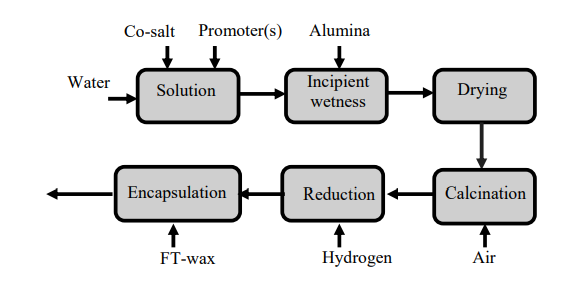
30 Sep 2023
It has been almost a century since FT was first conceptualized but recent developments are leading to a renewed interest in this proven technology to convert gas to liquids. At Amar, we are seeing many customers contact us for help in designing and fabricating skids to perform lab and pilot scale testing of FT processes.
Fundamentally, FT allows catalytic conversion of syngas (a mixture of H2 and CO) to higher hydrocarbons such as diesel or gasoline. Historically the interest was producing fuels but in recent years gas to chemicals projects are becoming more common. The refinery of the future would have a larger emphasis on producing chemicals and FT processes can be tuned to produce specific products such as higher alcohols.
One such mode of operation starts from coal and a typical block diagram is given below based on work by the US-Department of Energy (Reference: Fischer-Tropsch Synthesis, Catalysts and Catalysis by Burton Davis Elsevier 2007):

Most FT processes produce a complex mixture of Hydrocarbons whose distribution can be predicted with an ASF (Anderson Schulz Flory) distribution. The main goal of lab and pilot work is to fine-tune this product slate distribution in the syn crude (synthetic crude) that a Fischer Tropsch Plant would produce. FT is a catalytic process and historically Iron and Cobalt have been the dominant catalysts. However, catalyst design is still an art and most customers want to build rigs to either test commercially available catalysts or to characterize the results of their own catalyst development efforts.
Below are photos of some recent pilot plants designed by Amar for customers for their FT project.
Some of the major industrial-scale FTS plants are the ones below:
These are just a few examples of operational plants that employ Fischer-Tropsch synthesis on a large scale. The technology is of interest to regions with abundant natural gas or coal resources, as it allows them to convert these resources into valuable liquid hydrocarbon products. Additionally, research and development efforts are ongoing to make Fischer-Tropsch synthesis more efficient and sustainable, with potential applications in carbon capture and utilization (CCU) and renewable energy storage.
Top of Form
Niche clients such as the airline industry typically cannot use batteries or hydrogen in a realistic manner to cater to their sustainability goals. For aircraft engines, the only viable option is to create Jet Fuel / Aviation Turbine Fuel that has been produced from renewable feedstock. One option is to generate syngas from biomass and then use FT to convert this to suitable liquid fuels. This is a practical option since most of the existing fuel distribution network can be used and aircraft systems (especially engines) will not require to be redesigned.
However, a major challenge is the tough and stringent regulations that are mandated for the quality of aircraft fuels. Past customers have designed FT pilot plants to generate test quantities of ATF for testing and regulatory approval. We welcome you to approach our Pilot Plant design team at Amar for all your FT testing requirements.
FT is a highly exothermic reaction and much of the reactor innovations are driven by designs that improve heat transfer. Customers also use our reactors to prepare the catalyst required for FT projects. A typical flowsheet from work by Statoil, Norway (Reference: Fischer-Tropsch Synthesis, Catalysts and Catalysis by Burton Davis Elsevier 2007) is shown below. Commonly used FTS catalysts include the ones below:

To summarize, Amar has significant past experience designing and building pilot plant and lab testing skids for FTS and associated catalysts. Please contact us at sales@amarequip.com for an evaluation by our process design team and fabrication experts.